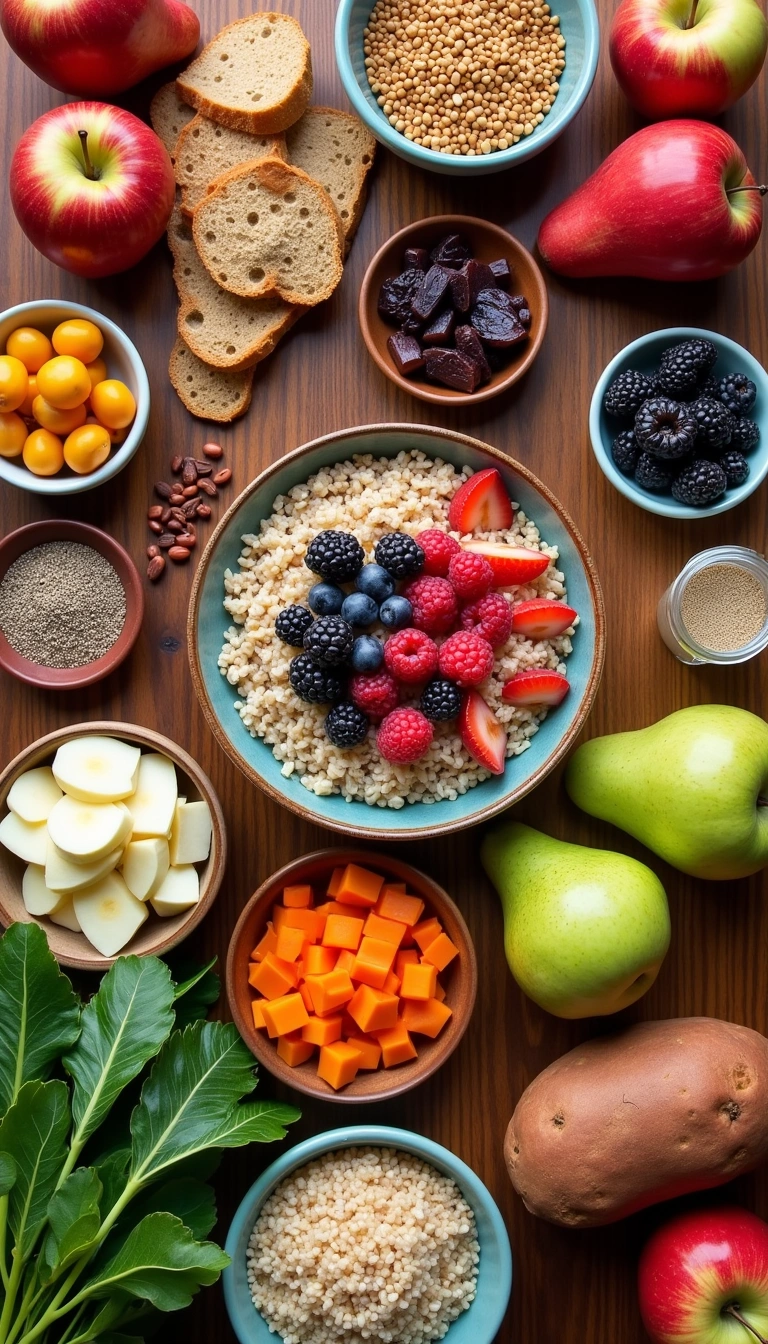High fiber foods for constipation can transform your digestive health when you choose the right meals. Your body craves natural solutions that work gently yet effectively. Smart food choices deliver relief without harsh medications or uncomfortable side effects. The path to better digestion starts with filling your plate with fiber-rich powerhouses. Constipation affects millions of Americans daily, causing discomfort and disrupting normal routines.
You don’t need to suffer through sluggish bowel movements when nature provides powerful remedies. The right combination of soluble and insoluble fiber creates the perfect storm for digestive relief. Your digestive system works best when you feed it foods that promote healthy gut bacteria and regular elimination. Understanding which meals pack the most fiber punch helps you make informed choices.
Let’s explore the top high-fiber foods that can bring quick constipation relief to your daily routine.
1. Start Your Day with Fiber-Rich Oatmeal

Oatmeal stands as one of nature’s most effective digestive aids for morning relief. The soluble fiber in oats forms a gel-like substance that softens stool and promotes easier passage. This breakfast champion contains beta-glucan fiber that feeds beneficial gut bacteria while encouraging regular bowel movements.
A single cup of cooked oatmeal delivers about 4 grams of fiber, making it an excellent foundation for your morning routine. Steel-cut oats provide even more fiber than instant varieties, giving you maximum digestive benefits. Top your bowl with fresh berries or sliced banana to boost the fiber content even higher.
Tip: Add one tablespoon of ground flaxseed to your oatmeal for an extra 2 grams of fiber and omega-3 fatty acids.
2. Load Up on Leafy Green Vegetables
Dark leafy greens like spinach, kale, and Swiss chard pack impressive amounts of insoluble fiber that adds bulk to stool. These nutrient-dense vegetables also contain magnesium, which helps relax intestinal muscles and promotes smoother digestion. Your colon benefits from both the fiber content and the natural water found in fresh greens.
One cup of cooked spinach provides about 4 grams of fiber while delivering essential vitamins and minerals. Raw kale offers even more fiber per serving, with one cup containing nearly 3 grams. Steam these vegetables lightly or add them to smoothies to preserve their natural digestive benefits.
Takeaway: Aim for at least two cups of leafy greens daily, either in salads, smoothies, or as cooked side dishes.
3. Choose Whole Grain Bread Over Refined Options
Whole grain bread contains the complete grain kernel, including the fiber-rich bran layer that refined bread lacks. This natural fiber helps create softer, more voluminous stools that move through your digestive tract more easily. The complex carbohydrates in whole grains also feed healthy gut bacteria that support regular elimination.
Two slices of whole grain bread typically provide 6-8 grams of fiber compared to just 2 grams in white bread. Look for breads listing “whole wheat flour” or “whole grain flour” as the first ingredient. Sprouted grain breads offer additional digestive benefits and are often easier for sensitive stomachs to handle.
Tip: Make a high-fiber sandwich using whole grain bread, avocado, and plenty of fresh vegetables for a constipation-fighting meal.
4. Snack on Fresh Apples with the Skin On
Apples deliver both soluble and insoluble fiber, making them perfect natural remedies for digestive sluggishness. The skin contains most of the insoluble fiber that adds bulk to stool, while the flesh provides soluble fiber that helps soften waste material. This combination creates ideal conditions for comfortable, regular bowel movements.
A medium apple with skin provides about 4 grams of fiber and natural sugars that can stimulate digestive activity. The pectin in apples acts as a prebiotic, feeding beneficial gut bacteria that support healthy digestion. Eat apples as snacks or add sliced apples to salads and oatmeal for extra fiber.
Takeaway: Keep fresh apples handy for quick fiber boosts throughout the day, always eating the nutrient-rich skin.
5. Add Beans and Legumes to Your Weekly Menu
Beans and legumes rank among the highest fiber foods available, with some varieties containing up to 15 grams per cup. Black beans, kidney beans, chickpeas, and lentils provide both soluble and insoluble fiber that promotes healthy digestion. These protein-rich foods also contain resistant starch that feeds beneficial gut bacteria.
One cup of cooked black beans delivers an impressive 15 grams of fiber, nearly half your daily requirement. Lentils cook quickly and provide about 8 grams of fiber per half-cup serving. Start with smaller portions if you’re not used to eating beans, gradually increasing amounts to avoid gas and bloating.
Tip: Rinse canned beans thoroughly before eating to reduce sodium content and make them easier to digest.
6. Include Pears in Your Daily Fruit Intake
Pears contain higher fiber levels than most fruits, with one medium pear providing about 6 grams of digestive-supporting fiber. The combination of soluble and insoluble fiber in pears helps regulate bowel movements while supporting healthy gut bacteria. Fresh pears also contain natural sorbitol, a sugar alcohol that can help stimulate bowel movements.
Asian pears and Bartlett pears offer slightly different fiber profiles but both provide excellent digestive benefits. Eat pears with the skin on to maximize fiber intake, as much of the insoluble fiber concentrates in the peel. Add sliced pears to yogurt or oatmeal for a fiber-rich breakfast or snack.
Takeaway: Include one fresh pear daily in your diet, eaten with the skin for maximum constipation-relieving benefits.
7. Incorporate Ground Flaxseed into Meals
Ground flaxseed serves as a fiber powerhouse, delivering both soluble and insoluble fiber in concentrated amounts. Just one tablespoon provides 3 grams of fiber along with healthy omega-3 fatty acids that reduce inflammation in the digestive tract. The mucilage in flaxseed creates a gel-like substance that helps soften stool and promote easier elimination.
Unlike whole flaxseeds that pass through your system undigested, ground flaxseed releases its nutritional benefits more effectively. The lignans in flaxseed also support healthy gut bacteria and may help regulate hormones. Store ground flaxseed in the refrigerator to prevent the healthy oils from going rancid.
Tip: Start with one teaspoon of ground flaxseed daily and gradually increase to one tablespoon to avoid digestive discomfort.
8. Make Chia Seeds Part of Your Routine
Chia seeds expand dramatically when mixed with liquid, creating a gel-like consistency that promotes healthy digestion. These tiny seeds pack an incredible 10 grams of fiber per ounce, making them one of the most fiber-dense foods available. The soluble fiber in chia seeds helps slow digestion and creates softer, easier-to-pass stools.
When soaked in water or milk, chia seeds develop a pudding-like texture that many people find satisfying and filling. This expansion also helps the seeds work more effectively in your digestive system. Mix chia seeds into smoothies, yogurt, or oatmeal for an easy fiber boost that supports regular elimination.
Takeaway: Soak two tablespoons of chia seeds in water for 15 minutes before adding to meals for optimal digestive benefits.
9. Choose Brown Rice Instead of White Rice
Brown rice retains its fiber-rich bran layer, providing significantly more digestive benefits than processed white rice. One cup of cooked brown rice contains about 4 grams of fiber compared to less than 1 gram in white rice. The complex carbohydrates in brown rice also support healthy gut bacteria that aid in regular bowel movements.
Wild rice and other whole grain rice varieties offer even more fiber and nutrients than standard brown rice. These unprocessed grains take longer to digest, providing sustained energy while supporting digestive health. Cook brown rice in batches and use it throughout the week in various meals.
Tip: Replace white rice with brown rice gradually by mixing the two types together until your taste preferences adjust.
10. Snack on Raw Vegetables with Hummus
Raw vegetables like carrots, celery, bell peppers, and broccoli provide crunchy sources of insoluble fiber that add bulk to stool. Pairing these vegetables with fiber-rich hummus creates a perfect constipation-fighting snack combination. The chickpeas in hummus contribute additional fiber while providing protein and healthy fats.
Carrots contain about 2 grams of fiber per medium carrot, while bell peppers provide similar amounts along with vitamin C. Raw broccoli florets offer even more fiber per serving and contain compounds that support liver detoxification. Keep pre-cut vegetables in your refrigerator for easy snacking throughout the day.
Takeaway: Prepare a weekly batch of cut vegetables and pair them with homemade or store-bought hummus for convenient high-fiber snacks.
11. Add Prunes to Your Anti-Constipation Arsenal
Prunes have earned their reputation as nature’s digestive aid due to their high fiber content and natural sorbitol. Just four prunes provide about 3 grams of fiber along with compounds that stimulate intestinal contractions. The combination of fiber, sorbitol, and natural fruit acids makes prunes particularly effective for constipation relief.
Prune juice offers similar benefits but with less fiber than whole prunes, making whole fruits the better choice for digestive health. Many people find that eating 4-6 prunes daily provides gentle, effective relief from constipation. Soak dried prunes in water overnight to make them softer and easier to digest.
Tip: Start with 2-3 prunes daily and gradually increase the amount based on your body’s response and comfort level.
12. Include Sweet Potatoes in Your Meal Planning
Sweet potatoes provide both soluble and insoluble fiber along with natural sugars that can help stimulate digestive activity. One medium baked sweet potato contains about 4 grams of fiber, especially when you eat the nutrient-rich skin. The beta-carotene in sweet potatoes also supports overall digestive health and immune function.
Baking, roasting, or steaming sweet potatoes preserves their fiber content better than other cooking methods. The natural sweetness makes them appealing to most palates while delivering serious digestive benefits. Cut sweet potatoes into cubes and roast them as a side dish or add them to soups and stews.
Takeaway: Bake sweet potatoes in batches and use them throughout the week in various meals, always eating the fiber-rich skin. Remember to increase your water intake as you add more fiber to your diet, as fiber works best when combined with adequate hydration. Gradually introduce these high-fiber foods to allow your digestive system to adjust comfortably. With consistent choices and patience, you’ll develop sustainable eating habits that support long-term digestive health and regular elimination.

Lifebing is driven by an unrelenting passion for promoting health and well-being, our team is wholly committed to curating exceptional content and immersive experiences.
